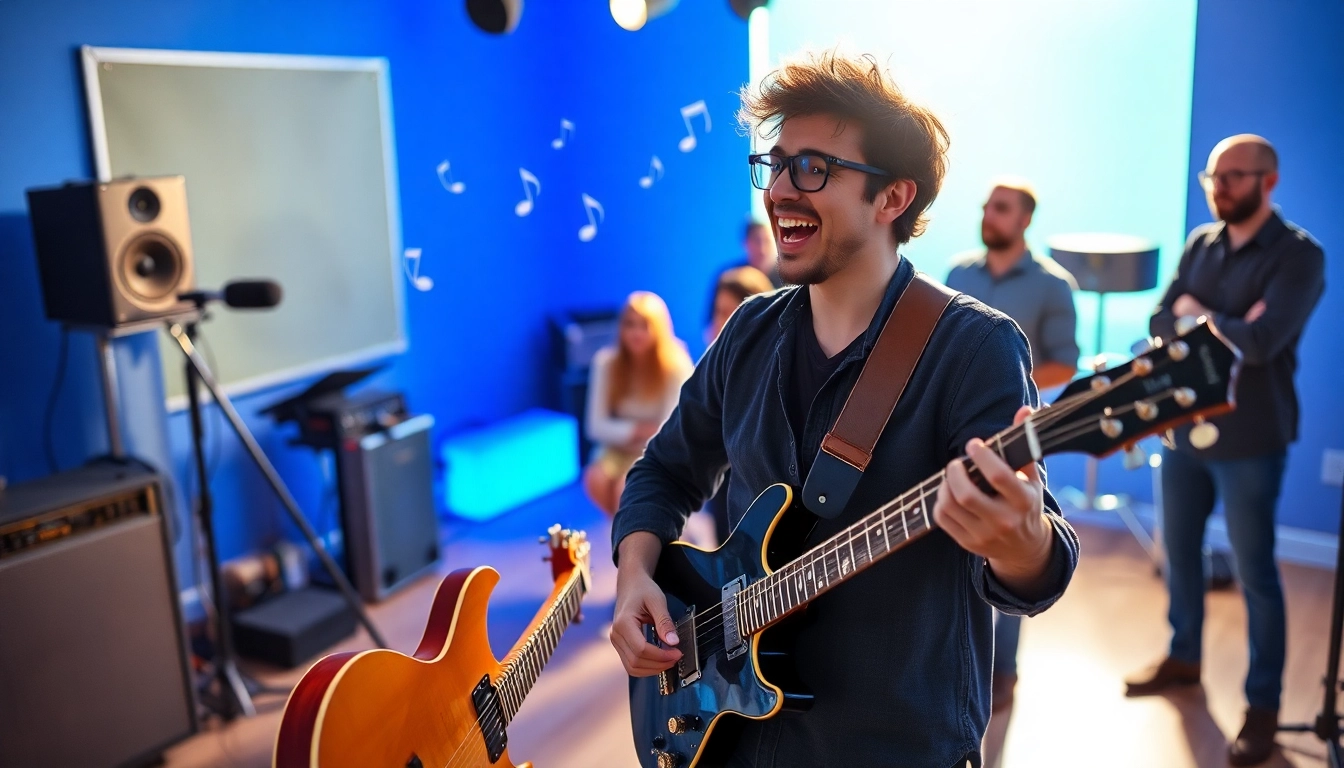Understanding the Basics of Music Pitching
What Is Music Pitching?
Music pitching is the process where artists, songwriters, or music promoters present their music to curators, influencers, or media outlets with the aim of securing exposure. This could mean getting songs added to playlists, featured in blogs, or considered for radio play. The goal is to connect with an audience that appreciates music, opening doors for the artist’s work to be discovered and promoted further.
The Importance of Music Pitching for Indie Artists
For independent artists, music pitching is crucial in a landscape dominated by mainstream acts. Artists who successfully navigate the pitching process can generate significant traction and build a dedicated following without the backing of a major label. This approach enables them to maintain creative control while reaching out to listeners through playlists and other platforms. Realizing the potential of music pitching can exponentially increase an artist’s visibility and can be a game-changer in their music careers.
Common Mistakes in Music Pitching
Despite its importance, many artists make mistakes when pitching their music, hampering their chances of success. Common pitfalls include:
- Lack of Research: Not knowing the target audience or curator’s music preferences leads to ineffective pitches.
- Generic Messages: Generic, cookie-cutter pitch messages often fail to catch the attention of curators.
- Timing Issues: Pitching too late or too early can result in artists missing crucial opportunities, especially before a song’s release.
- Failure to Follow-Up: Not following up on submitted pitches can show disinterest in collaboration.
Preparing Your Music Pitch
Identifying Your Target Audience and Curators
The first step in preparing a music pitch is identifying who the music will resonate with the most. It’s essential to research potential curators and influencers who align with your music style. Look into:
- Social media profiles of curators and their previous works.
- Genres and types of playlists they curate.
- Engagement levels with audiences—how often they post, and their follower count.
By honing in on your target audience, you can tailor your pitches effectively. For example, if you’re an indie rock artist, consider reaching out to playlist curators who focus specifically on that genre rather than broader playlists.
Crafting a Compelling Pitch Message
Your pitch message is your opportunity to make a strong first impression. To craft it effectively:
- Be Concise: Keep your pitch snappy, usually around 150-200 words. Highlight your best features without overwhelming the curator.
- Personalize Your Message: Show genuine interest in the curator’s work and explain why your music is a good fit for their playlist or blog.
- Include Highlights: Briefly mention any achievements, previous collaborations, or notable placements to highlight your credibility.
A compelling example of a pitch could be: “Hi [Curator’s Name], I’m [Your Name], an indie artist based in [Location]. I’ve recently released [Song Title], which explores [Song Theme]. I believe it would resonate well with your [Playlist Name], as it complements artists like [Similar Artist]. In my last release, I was featured on [Notable Platform] where I reached [Key Metrics]. I’d appreciate your consideration!”
Essential Elements of Your Music Submission
Your submission should encompass several crucial elements that capture the curator’s interest:
- Streaming Links: Provide direct links to your music on major platforms like Spotify, Apple Music, or SoundCloud.
- Bio: Include a brief bio that connects to the music. Personal stories or experiences that inspired your work can create a connection.
- High-Quality Photos: Professional images strengthen your brand and give curators visual content to share.
- Press Kit: Consider creating an electronic press kit (EPK) with all vital information about you and your music.
Execution of Music Pitching
Platforms for Music Pitching
Numerous platforms facilitate music pitching, each offering unique avenues for artists. Some notable ones include:
- SubmitHub: A popular platform where artists can submit their music to playlist curators and bloggers for feedback.
- SoundCloud: Use SoundCloud to share your tracks and engage with a community of curators who might discover your music organically.
- Social Media: Directly connect with curators on platforms like Instagram and Twitter. Tailored DMs can present informal pitching opportunities.
- Direct Email: Research emails for curators and industry professionals to send personalized pitches directly.
Timing Your Music Pitch Effectively
Timing can significantly impact the success of your pitch. Here are some key considerations:
- Single Releases: Aim to pitch your music at least four weeks in advance of your release date. This gives curators adequate time to consider your submission.
- Seasonal Trends: Recognize seasons or particular times of year when specific types of music perform better—summer for upbeat tracks, winter for reflective songs, etc.
- Special Dates: Linking your release to relatable content or events (like a holiday) can help your music gain traction.
Building Relationships with Curators
Music pitching is not just about one-off submissions; it’s also about relationship building. Developing a rapport with curators places you in a favorable position for future engagements:
- Engagement: Regularly interact with curators on social media, share their content, or comment on their posts to get on their radar.
- Networking: Attend music industry events, workshops, and online webinars where curators might be present to cultivate in-person connections.
- Follow-Up: A polite follow-up (after an appropriate length of time) can show your continued interest in collaboration and respect for their time.
Best Practices for Successful Music Pitching
Do’s and Don’ts of Music Pitching
Adopting best practices can ensure your pitches are well-received. Here are the do’s and don’ts to guide you:
- Do:
- Research your targets extensively before pitching.
- Maintain a clear and professional tone in your communication.
- Be patient and respectful of curators’ decision-making processes.
- Don’t:
- Send mass pitches to multiple curators, risking a lack of personalization.
- Get discouraged by rejections; use it as learning for future pitches.
- Be overly aggressive or pushy in your follow-ups.
Successful Pitch Examples from Top Artists
Many successful artists attribute part of their career growth to effective pitching strategies. For instance:
- Adele: Before she became a household name, she utilized connections and engaged with music bloggers, resulting in features that surged her early singles.
- Chance the Rapper: He gained attention through organic playlists; his strategic engagement with curators paved the way for his breakthrough success while remaining independent.
Both artists emphasize authenticity, storytelling, and building genuine relationships, showcasing that compelling connections can lead to tangible outcomes.
Analyzing Feedback and Adjusting Strategies
Once you begin pitching, it’s crucial to analyze feedback and outcomes systematically. Successful artists iterate based on what they learn:
- Track Responses: Create a log of pitches sent, responses received, and notes on what future improvements could be made.
- Identify Patterns: Look for recurring themes in rejection reasons to adapt future pitches effectively.
- Seek Constructive Criticism: If you have personal relationships with curators, don’t hesitate to ask for feedback on how your music might better align with their playlists.
Measuring the Impact of Your Music Pitching
Tracking Engagement and Conversion Rates
Once your music is out there, measuring its success becomes critical. Use analytics tools provided by streaming platforms to track:
- Listener Engagement: Monitor how often your music is streamed, skipped, or shared.
- Playlist Additions: Count how many playlists your songs are featured in to evaluate your pitching success.
- Social Media Metrics: Assess the engagement levels on your promotional posts, including likes, shares, and comments.
Utilizing Data to Enhance Future Pitching
The data collected from your previous pitches and music performance can provide insights for your future strategies:
- Use observed engagement patterns to optimize the timing and selection of future pitches.
- Identify high-performing aspects of your marketing or pitching materials to enhance their quality in the future.
- Adjust your target list of curators based on past successes and failures.
Long-Term Strategies for Sustained Success
Ultimately, successful music pitching is about continual progress and adaptation. Prioritize long-term relationships and consistent engagement. Consider these strategies:
- Continuous Learning: Stay updated on industry trends and adapt your strategies accordingly through ongoing education and networking.
- Regular Content Creation: Keep releasing new material to maintain momentum and constantly engage with your audience.
- Developing Personal Brand: Create a brand that resonates with listeners, built upon your unique story and musical style.









